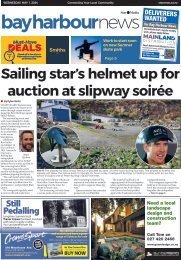Bay Harbour: February 26, 2020
You also want an ePaper? Increase the reach of your titles
YUMPU automatically turns print PDFs into web optimized ePapers that Google loves.
PAGE 8 Wednesday <strong>February</strong> <strong>26</strong> <strong>2020</strong><br />
BAY HARBOUR<br />
Latest Canterbury news at starnews.co.nz<br />
Your Local Views<br />
Oil spills always a concern<br />
Environment<br />
Canterbury<br />
deputy<br />
harbourmaster<br />
Guy Harris<br />
writes about<br />
marine oil<br />
spills and how<br />
and why the appropriate<br />
responses are determined<br />
in light of a recent incident<br />
near Akaroa Heads<br />
THANKFULLY, marine oil<br />
spills are rare in Canterbury.<br />
Environment Canterbury<br />
works proactively with operators<br />
to help ensure they do not have<br />
oil spills, and that appropriate<br />
response equipment is available<br />
should a spill occur. However,<br />
when an oil spill does happen,<br />
we have powers under the<br />
Maritime Transport Act 1994 to<br />
intervene.<br />
When determining the appropriate<br />
response, ECan maintains<br />
a number of oil spill response<br />
equipment sites around the region,<br />
at Lyttelton and Akaroa, as<br />
well as Christchurch, Kaikōura<br />
and Timaru.<br />
Our equipment and team of<br />
trained responders allow for a<br />
swift response to a spill. Gear<br />
and training of responders is<br />
funded through the Oil Pollution<br />
Fund, managed by Maritime<br />
New Zealand and created<br />
by a levy on shipping.<br />
On receiving a report of a spill,<br />
we must first verify the report<br />
and identify a few facts, including:<br />
· What type of oil is it?<br />
· Where is the oil?<br />
· How much oil is there?<br />
· Where is it moving to?<br />
· What sensitive sites are nearby?<br />
Armed with this information,<br />
a specific response can be<br />
mounted. We have a comprehensive<br />
response plan to draw on,<br />
which provides guidance on how<br />
to respond and allows for local<br />
sensitivities and resources to be<br />
identified and protected. An important<br />
part of any response is<br />
the notification and involvement<br />
of key stakeholders.<br />
Every spill response will have<br />
differing actions and complexities,<br />
but the aim is always to help the<br />
environment to recover. As such,<br />
actions taken should have an<br />
overall net environmental benefit<br />
– ie: the response should leave the<br />
environment in a better condition<br />
than if the oil were left there.<br />
A recent oil pollution incident<br />
occurred near Akaroa heads. A<br />
recreational boat hit a rock and<br />
sunk quickly; thankfully, everybody<br />
was retrieved safely.<br />
However, our incident<br />
response team received a call<br />
about a possible oil slick in the<br />
area. Using reports from local<br />
tour boat operators and the harbourmaster’s<br />
office navigation<br />
cameras, we ascertained that<br />
the slick was a very thin sheen<br />
of diesel, most likely from the<br />
sunken boat.<br />
The most effective and prompt<br />
manner of removing the remaining<br />
oil was to salvage the vessel.<br />
The vessel’s insurer engaged a<br />
marine contractor to recover<br />
the vessel and contain the oil<br />
onboard.<br />
The response included assessments<br />
of the local wildlife<br />
and sensitive sites, access to the<br />
area, and response options that<br />
may be utilised. The contractor<br />
checked the area; apart from a<br />
small bit of flotsam, which was<br />
collected, no sign of the boat<br />
was found – even using sonar.<br />
• WHAT YOU CAN DO TO<br />
HELP: If you do discover an<br />
oil spill, whether on the sea<br />
or land, please phone the<br />
incident response team on<br />
our 24-hour hotline, 0800<br />
765 588 – we are ready and<br />
waiting.<br />
No more diesel has been spotted<br />
since, in spite of the area being<br />
checked multiple times by local<br />
operators on our behalf.<br />
It is likely that the thin sheen<br />
of diesel would have been broken<br />
up by the swell and then would<br />
have evaporated quickly in the<br />
hot weather.<br />
To give an idea of how little<br />
diesel it takes to make a badlooking<br />
spill, around 100ml<br />
– less than half a cup – of diesel<br />
can disperse to create a rainbow<br />
sheen (which is about 3-4 microns<br />
thick) the size of a tennis<br />
court. Oil spill response is about<br />
working out the most effective<br />
methods of response that causes<br />
the least environmental harm.<br />
On a final note, recently another<br />
call came into the incident response<br />
team regarding a thin rainbow<br />
sheen in Akaroa, this time<br />
around the wharf in French <strong>Bay</strong>.<br />
Contractors have tested the<br />
pipework and tanks associated<br />
with the diesel bowser on the<br />
wharf, but nothing has been<br />
found to be wrong and investigations<br />
will continue.<br />
As an aside, it is worth noting<br />
that the wharf is currently in<br />
the early planning stage of a<br />
Christchurch City Council rebuild<br />
project and the fuel supply<br />
infrastructure is being discussed<br />
as part of this.<br />
BIRDS OF THE ESTUARY<br />
Tanya Jenkins is the manager of the Avon-<br />
Heathcote Estuary Ihutai Trust, a non-profit<br />
organisation formed in 2002 to protect one of<br />
New Zealand’s most important coastal wetlands.<br />
Each week she introduces a new bird found<br />
in the estuary. Her column aims to raise the<br />
understanding of the values and uniqueness of<br />
the area.<br />
Don’t let the clever<br />
pukeko fool you<br />
THE PUKEKO or swamp hen<br />
are a well-known, heavyweight<br />
native resident – with male birds<br />
weighing up to 1.1kg.<br />
Some people may call them<br />
“dumb birds” for getting on<br />
roads to become roadkill,<br />
however, pukeko are actually<br />
extremely clever and complex<br />
birds.<br />
Don’t be fooled by the pukeko<br />
running around clumsily along<br />
the road as they can swim, run<br />
and fly extremely well.<br />
Pukeko are commonly seen<br />
on regularly mown roadsides<br />
as they love the fresh new grass<br />
shoots and growth there.<br />
That, paired with their need<br />
to eat grit off the road, (this aids<br />
them in their digestion of tough<br />
to digest foods like grass) puts<br />
them at high risk of being run<br />
down by motorists.<br />
Pukeko live in small community<br />
groups and are very protective<br />
of their territory, hence why<br />
you can hear their loud shrieking<br />
when they defend their patch.<br />
Females in the group will lay<br />
as many as 19 eggs in one shared<br />
nest, which is incubated by the<br />
males. When chicks hatch, the<br />
entire group, whether they are<br />
breeding and non breeding<br />
birds, will feed the chicks for<br />
about three months. Now that’s<br />
clever.<br />
How can we help these birds<br />
thrive? Keep dogs on the lead<br />
when walking near waterways as<br />
to not disturb them while they<br />
are nesting, feeding or resting.<br />
Drive carefully along roads<br />
where you see pukeko regularly<br />
and slow down.<br />
PROTECTIVE: Pukeko are misinterpreted as being “dumb birds,”<br />
however, they are quite complex and clever.<br />
PHOTO: BRIAN BETTS


















